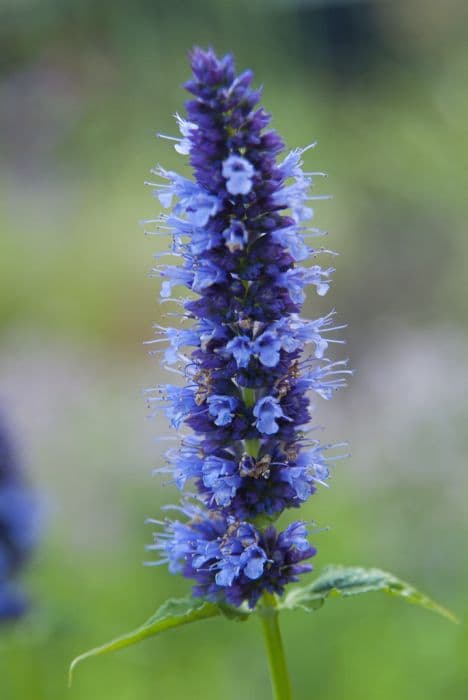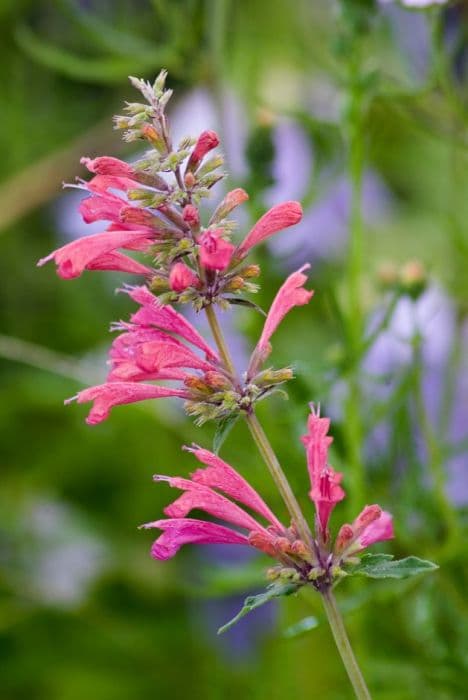Doone Valley Thyme Thymus 'Doone Valley' (v)

ABOUT
Thymus 'Doone Valley', commonly known as Doone Valley thyme, is a visually attractive plant that features a mat-forming growth habit, creating a carpet-like appearance. The foliage of the Doone Valley thyme is particularly striking, showcasing small, rounded leaves that boast a vibrant green color, often sprinkled with yellow or gold variegation. These colorful leaves can sometimes turn more golden or even exhibit hints of lemon in brighter sunlight, providing a striking contrast against the greenery in a garden setting. During the blooming season, Doone Valley thyme produces clusters of tiny, tubular flowers that add a decorative touch to the plant. These flowers are typically a soft lilac or pink-purple hue, lending a delicate and beautiful splash of color atop the variegated leaves. The blooms are known to attract bees and other pollinators, making the plant not only a visual delight but also beneficial to garden ecology. The overall appearance of Doone Valley thyme, with its ornamental leaves and charming flowers, makes it a popular choice for ground cover, rock gardens, and as an aromatic, culinary herb.
About this plant
 Names
NamesFamily
Lamiaceae
Synonyms
Doone Valley Thyme, Lemon Variegated Thyme
Common names
Thymus 'Doone Valley'
 Toxicity
ToxicityTo humans
Thyme 'Doone Valley' is considered non-toxic to humans and is commonly used as a culinary herb. There are no well-documented cases of poisoning from consuming Thyme 'Doone Valley'. However, it is always wise to consume plants in moderation and with certainty about their identification, as excessive consumption of any plant material may cause digestive discomfort. It's also worth noting some individuals may have allergic reactions or sensitivities to thyme that could result in mild symptoms such as dermatitis when handling the plant or gastrointestinal upset if consumed in large quantities.
To pets
Thyme 'Doone Valley' is generally considered non-toxic to pets such as dogs and cats. This plant is often used in cooking and for its aromatic properties, and there are no significant reports of it causing harm to animals when ingested in small, culinary amounts. However, as with any non-food plant, consumption in large amounts could potentially cause mild gastrointestinal upset, such as vomiting or diarrhea, due to the unusual plant material in the animal's diet. Always monitor your pets and keep them from eating large quantities of any plant material, including Thyme 'Doone Valley'.
 Characteristics
CharacteristicsLife cycle
Perennials
Foliage type
Evergreen
Color of leaves
Variegated
Flower color
Pink
Height
6 inches (15 cm)
Spread
18 inches (45 cm)
Plant type
Herb
Hardiness zones
5
Native area
Europe
Benefits
 General Benefits
General Benefits- Aromatic Foliage: Thymus 'Doone Valley', commonly known as lemon thyme, has fragrant leaves that release a pleasant lemon scent when bruised or crushed, providing sensory enjoyment in the garden.
- Culinary Uses: The leaves of lemon thyme can be used to flavor a variety of dishes, including meats, soups, and sauces, making it a versatile herb for cooking.
- Attracts Pollinators: Lemon thyme blooms with small flowers that attract bees and other pollinators, enhancing the health and biodiversity of the garden ecosystem.
- Ground Cover: This plant serves as an excellent low-growing ground cover, filling in spaces and suppressing weeds with its dense mat of foliage.
- Drought Tolerance: Once established, lemon thyme is drought-tolerant, making it suitable for xeriscaping and low-water gardening practices.
- Ornamental Value: With its variegated green and gold leaves, lemon thyme provides visual interest and ornamental value to garden beds, borders, and containers.
- Easy to Grow: This herb is generally easy to grow and maintain, requiring minimal care once established in the right conditions.
 Medical Properties
Medical Properties- Antiseptic: Thyme contains thymol, a compound with antiseptic properties.
- Antifungal: It may help in treating fungal infections due to its antifungal effects.
- Antispasmodic: Thyme has been traditionally used to alleviate coughs and other spasm-related symptoms.
- Expectorant: Helps in the expulsion of mucus from the airways, possibly easing symptoms of bronchitis and coughs.
- Carminative: Thyme may aid in the reduction of gas and bloating.
- Antioxidant: Known to possess antioxidant properties, which can help to protect cells from oxidative damage.
- Antimicrobial: May help to inhibit the growth of various bacteria and viruses.
 Air-purifying Qualities
Air-purifying QualitiesThis plant is not specifically known for air purifying qualities.
 Other Uses
Other Uses- As a natural furniture polish: The fragrant oil from lemon thyme leaves can be used to polish wooden furniture, leaving a pleasant aroma.
- In homemade soap: Lemon thyme can be infused into soap for its fragrance and potential antibacterial properties.
- As a moth repellent: Dried lemon thyme can be placed in sachets and used to repel moths in wardrobes and drawers.
- In potpourri: The leaves and flowers of lemon thyme can be added to potpourri mixtures for a refreshing citrus scent.
- As a natural dye: Lemon thyme can be used to create a natural yellow dye for fabrics and textiles.
- In culinary salts: Finely chopped lemon thyme can be blended with sea salt to create a flavored salt for seasoning dishes.
- For shoe deodorizing: Dried lemon thyme leaves can be placed in shoes to help neutralize odors.
- In bath teas: Lemon thyme can be used in homemade bath tea blends for a relaxing and aromatic bathing experience.
- As a flavoring in homemade jellies: Lemon thyme can be added to fruit jellies for an unexpected twist of flavor.
- In aromatic firestarters: Dried lemon thyme can be included in homemade firestarters to release a pleasant scent when the fire is lit.
Interesting Facts
 Feng Shui
Feng ShuiThyme is not used in Feng Shui practice.
 Zodiac Sign Compitability
Zodiac Sign CompitabilityThyme is not used in astrology practice.
 Plant Symbolism
Plant Symbolism- Courage: Thymus 'Doone Valley', commonly known as thyme, has historically been associated with bravery. In ancient times, knights would often carry sprigs of thyme as a sign of courage to go into battle confidently.
- Strength: Thyme symbolizes strength, perhaps due to its robust nature and ability to thrive in difficult conditions, representing the idea of overcoming challenges.
- Healing: Since thyme is known for its medicinal properties, it also symbolizes healing. It was used in ancient herbal medicine to treat a variety of ailments, symbolizing the body's ability to recover.
- Cleansing: The plant has been used for its purifying qualities, thus representing cleansing of the mind, body, and spirit.
- Love and affection: In the language of flowers, thyme can represent affection, with its enduring yet gentle scent, symbolizing the presence of love even through adversity.
- Passing of Time: Given its name, thyme is also a play on the word "time," representing the passage of time and the enduring qualities of nature throughout the seasons.
 Water
WaterLemon thyme, the common name for Thymus 'Doone Valley', prefers to be watered deeply but infrequently, requiring water only when the top inch of the soil feels dry to the touch. As a general rule, watering once every week to ten days during active growing seasons (spring and summer) with approximately one gallon per square yard should suffice. During winter or cooler weather, reduce watering to once every two to three weeks, monitoring soil moisture levels to avoid waterlogging. Overwatering can lead to root rot, so ensure good drainage and let the soil dry out between waterings.
 Light
LightLemon thyme thrives in full sun conditions, meaning it should receive at least six hours of direct sunlight each day. Placing it in a south-facing location where it can bask in unobstructed light will encourage healthy growth. In regions with extremely hot climates, providing some light afternoon shade can prevent scorching, but generally, the more light lemon thyme receives, the better its growth and flavor.
 Temperature
TemperatureLemon thyme is hardy and can tolerate a range of temperatures, but it grows best in the 60°F to 70°F range. Mature plants can survive brief periods of frost and cold down to about -20°F. For optimal growth, avoid exposing lemon thyme to prolonged temperatures above 80°F or below freezing point for extended periods.
 Pruning
PruningPruning lemon thyme is essential for maintaining a compact, bushy growth and to encourage new, flavorful foliage. Trim it back in early spring to remove any dead or woody stems and again after flowering to maintain the desired shape. Light pruning throughout the growing season can also be beneficial, as it stimulates growth and prevents the plant from becoming leggy. The best time for major pruning is early spring or immediately after flowering.
 Cleaning
CleaningAs needed
 Soil
SoilDoone Valley Thyme thrives in well-draining soil with a pH between 6.0 and 8.0; a mix of loamy or sandy soil amended with compost is ideal. For optimal growth, ensure the soil is rich in organic matter but not overly fertile, as this can lead to lush foliage with poor flavor and weaker scent.
 Repotting
RepottingDoone Valley Thyme does not require frequent repotting; it should be repotted every 2-3 years or when the plant has outgrown its current container. It's a hardy plant that prefers to be slightly root-bound, so choose a pot only slightly larger than the previous one.
 Humidity & Misting
Humidity & MistingDoone Valley Thyme prefers a dry to moderate humidity level as it is a Mediterranean herb. Ideal humidity levels are between 40-70%; high humidity can lead to fungal diseases in this plant, so providing good air circulation is essential to mimic its natural dry habitat.
 Suitable locations
Suitable locationsIndoor
Place Doone Valley Thyme near a sunny window in well-draining soil.
Outdoor
Plant in full sun with well-draining soil; cut back after blooming.
Hardiness zone
5-9 USDA
 Life cycle
Life cycleThe 'Doone Valley' thyme (Thymus 'Doone Valley') starts its life cycle as a seed, which upon germination in favorable conditions, such as well-drained soil and full sunlight, develops into a small seedling. As the seedling grows, it forms a woody base and creeping stems, with the plant entering the vegetative stage where foliage expands and the characteristic lemon-scented, variegated leaves mature. During the flowering stage, usually from late spring to early summer, it produces clusters of purple-pink flowers that attract pollinators like bees. After pollination, the flowers develop into tiny nutlet fruits, each containing seeds, thereby completing the reproductive cycle. In temperate climates, 'Doone Valley' thyme is a perennial plant and will go dormant in winter, with growth slowing or stopping, and then resume growth with the return of warm weather in spring. If conditions are favorable and the plant is well-maintained, it can live for several years, spreading to form a low-growing mat and providing ground cover, culinary herbs, and ornamental appeal.
 Propogation
PropogationPropogation time
Spring-Early Summer
The Thymus 'Doone Valley', commonly known as Doone Valley thyme, is typically propagated during spring to early summer, which is the ideal time for plant growth and root establishment. One of the most popular methods for propagating Doone Valley thyme is stem cutting. To propagate by stem cuttings, a healthy, non-flowering shoot should be selected. A cutting of about 2 to 4 inches (5 to 10 cm) is made, removing the leaves from the lower half. The cut end can be dipped in rooting hormone to encourage root development, though this is not always necessary. The cutting is then placed in a well-draining soil mix, keeping the soil consistently moist but not waterlogged. Within a few weeks, the cutting should root, at which point it can be transplanted to its permanent location.





![Bugle [Sugar Plum]](/_next/image?url=https%3A%2F%2Fplants-admin.emdemapps.com%2Fimages%2Fplants%2F%2Fimages%2F604b597956a55.png&w=640&q=75)
![Bugle [Princess Nadia]](/_next/image?url=https%3A%2F%2Fplants-admin.emdemapps.com%2Fimages%2Fplants%2F%2Fimages%2F604b5806e268c.png&w=640&q=75)


